MXA MOTOCROSS RACE TEST: 2018 YAMAHA YZ250F
Q: FIRST AND FOREMOST, IS THE 2018 YAMAHA YZ250F BETTER THAN THE 2017 YZ250F?
A: That all depends on what color rims you favor, blue or black?
Q: WHAT CHANGES DID YAMAHA MAKE TO THE YZ250F FOR 2018?
A: When the all-new 2014 YZ250F hit the stage, it had silver Excel Takasago rims. They were not flashy by any means, but they stand the test of time, as the silver hides chips and scratches. In 2015 Yamaha jumped on the black-rim bandwagon and went with black Excel rims. In 2015 four of the six big manufacturers had black rims (Honda and Suzuki went with silver). Until 2016, the Suzuki RM-Z250 had silver rims. In 2017 Suzuki switched to black, meaning five of the six manufacturers all used black rims, leaving only the Honda CRF250 with silver. Stop the presses! Somebody finally made an earth-shattering technical move.
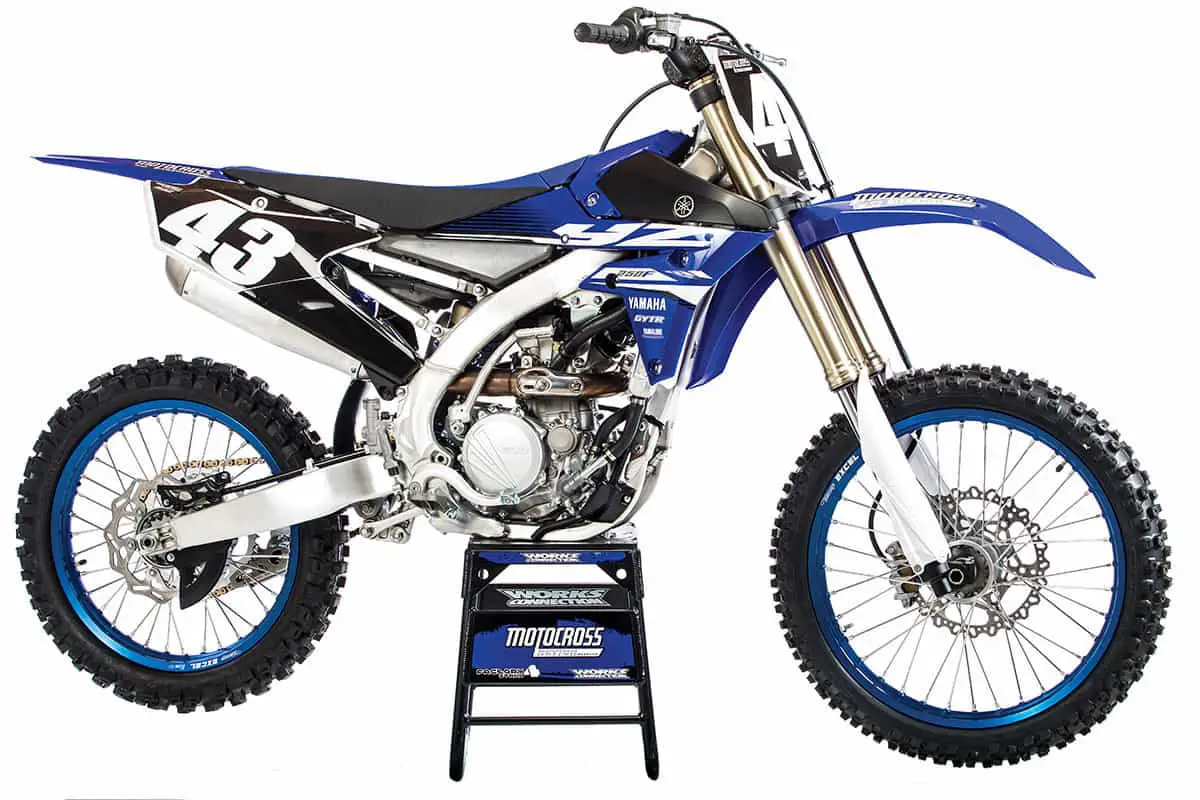 For 2018, the Yamaha YZ250F is the same as the 2017 model, save for BNG, blue rims and engine plugs and brushed aluminum clutch and ignition covers.
For 2018, the Yamaha YZ250F is the same as the 2017 model, save for BNG, blue rims and engine plugs and brushed aluminum clutch and ignition covers.
For 2018 Yamaha dared to be different from the rest and went with blue rims. It was a bold move. It could be said that the other manufacturers went black because their customers were buying black aftermarket rims for their bikes, which begs the question, how many Yamaha owners do you know who switched their black rims for blue ones? You are either going to love them or hate them.
Did Yamaha change anything else? Yes. They added blue-anodized engine plugs to accent the blue rims. We will give Yamaha credit for switching to a brushed-aluminum look on its ignition and clutch covers. They look better and look better longer. Did we mention the BNG as well?
Q: WHAT BIG CHANGES HAS YAMAHA MADE TO THE YZ250F SINCE IT KICKED THE CARBURETOR IN 2014?
A: It is hard to believe that it wasn’t until 2014 that Yamaha entered the world of fuel-injected 250cc motocross bikes. Strange but true.
2014: In 2014 the YZ250F was a hair shy of winning MXA’s 2014 250F shootout over the KX250F. The fuel-injected YZ250F was in its teething stages. The YZ250F was wide (and still is), and the KX250F was narrow. The KX250F was great on fast tracks, and the YZ250F was great on tight tracks. Both bikes had average cornering, but what set the two apart were the refinements. The YZ250F’s chassis was unbalanced. It had some hiccups in the ECU. The airbox Dzus fasteners were a nightmare, and there were uncharacteristic reliability issues.
2015: We didn’t expect any major updates for 2015, but Yamaha surprised us. In 2015 Yamaha targeted improving durability, rider comfort, engine performance and showroom appeal. The bike handled better and had a stronger engine, improved suspension settings and looked better. Although the KX250F got some upgrades in 2015, the YZ250F out-cornered and out-handled the KX250F, giving the YZ250F top honors in MXA’s 2015 shootout.
2016: In 2016 Yamaha made even more updates on the durability front and added an oversized 270mm front brake rotor. The bike had slightly better suspension settings and braking. That year the KTM 250SXF was all new and pumped out a whopping 43.79 horsepower over the YZ250F’s 39.35 horsepower. The KTM’s engine, however, was high-strung and thrived in a high-rpm environment. The Achilles heel of the KTM was its WP 4CS forks. They were Novice forks that couldn’t handle the engine’s potent power. No other bikes had major updates in 2016, making the YZ250F MXA’s back-to-back shootout winner.
2017: Yamaha knew something had to be done in 2017 to bridge the power gap with the Austrian steeds. The 2017 YZ250F had six major engine updates, which included a new cylinder head, air boot, camshaft, exhaust pipe, clutch and rev limiter. These engine updates pumped up the pony power 1 to 1.6 horsepower from 7000 rpm on up. Peak horsepower went from 39.88 to 40.56. There were also five major chassis updates in 2017:
(1) Yamaha stiffened the chassis torsionally by widening the forgings at the swingarm pivot by 12mm.
(2) The head stays were increased in area, and the lower motor mount plates were switched from aluminum to steel to fight engine shake and chassis flex.
(3) The footpegs were lowered 5mm.
(4) The upper fork stanchions were made more rigid to lessen binding.(5) The fork spring rate was decreased from 4.7 N/m to 4.6 N/m.
2018: No performance upgrades were made for the 2018 model, although we predict the YZ250F will follow in the 2018 YZ450F’s footsteps in 2019.
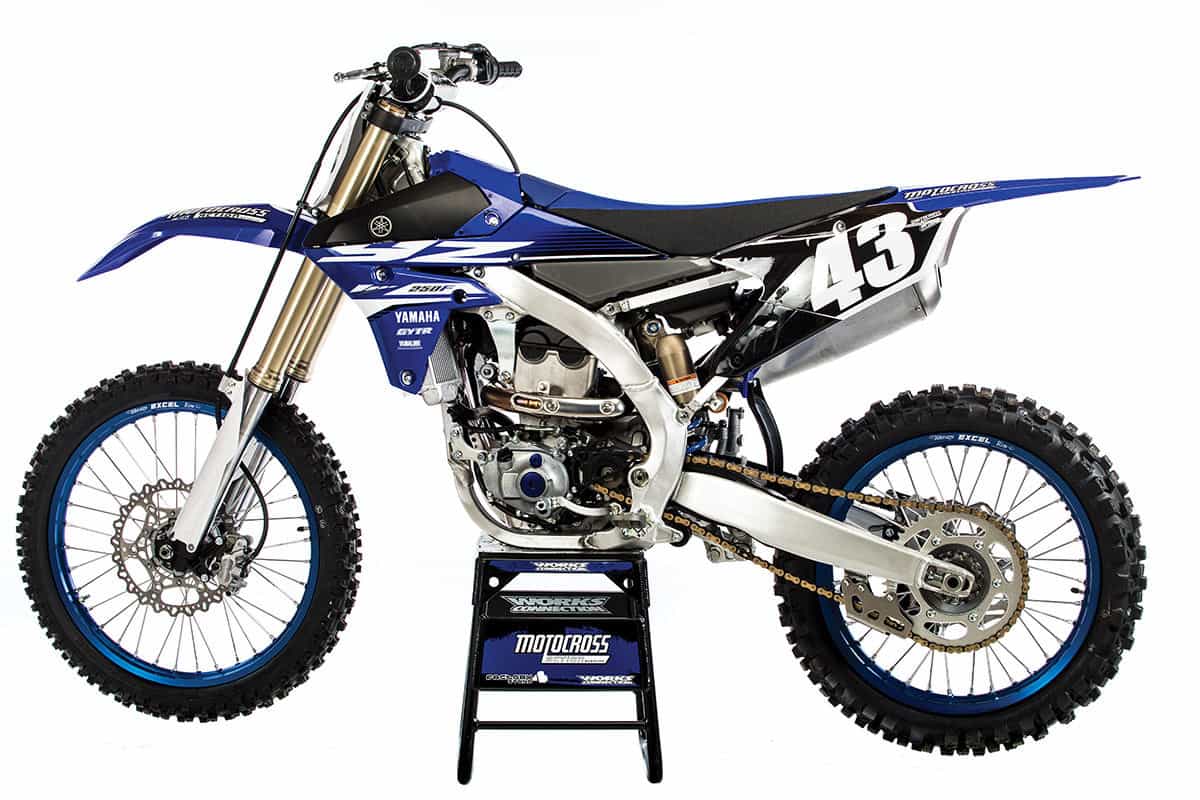 The YZ250F won the MXA 250F shootout in 2015 and 2016. It is a great bike for every rider, but it lacks power compared to its Austrian competition.
The YZ250F won the MXA 250F shootout in 2015 and 2016. It is a great bike for every rider, but it lacks power compared to its Austrian competition.
Q: HOW GOOD IS THE 2018 KAYABA SUSPENSION?
A: Yamaha was the only manufacturer that stood firm on not straying away from its tried-and-true coil-spring fork. Air forks shed weight and cut costs, but Suzuki and Honda (and we are guessing the KX450F in 2019) have cut their loses on the air fork to return to springs. It is funny, because KTM and Husky were the last to switch to air forks, and they now have an air fork that not only blows the Showa and Kayaba air forks out of the water on performance and functionality, but the WP AER fork is now nipping at the heels of the fabled Kayaba SSS fork.
Other than the performance of the SSS suspension, what is notable is its versatility. Riders big or small can find a comfortable setting with ease. We had testers from 130 pounds to 210 pounds run the same settings, save for race sag.
Q: HOW DOES THE 2018 YZ250F HANDLE?
A: The YZ250F shares its DNA with its big brother, the YZ450F. The YZ450F is not a great-cornering bike. It never has been. A lot of effort and focus are needed to put the big bike where you want it—and, in 2018, to keep it there once you get it in the sweet spot. While the 2018 YZ250F has some of its big brother’s flaws, they are minimized by the smaller displacement, lighter weight and decreased rotating mass. We raised the YZ250F forks up in the clamps until they were 9mm above the top triple clamp to put more weight on the front end. This allowed the Bridgestone 403 front tire to track the ground better; however, it threw the balance of the bike off and made the rear feel high. Given the choice of sliding the forks back down or sticking with a slightly high rear end, every test rider chose to go back to the more balanced chassis.
Fast, sweeping corners (where the rear end squatted), whoops and fast straights are where the YZ250F is most confidence-inspiring. The rear end tracks like glue and never steps out through consecutive whoops or high-speed sweepers. Summing up the YZ250F’s handling in one word, it is “predictable.” We know the front end is going to float around in the corners, but if you trust the back half of the YZ250F more than the front, it will do what you want time after time.
 The YZ250F engine has a power spread that is easy to use, yet still hits hard in the midrange to boost you out of corners.
The YZ250F engine has a power spread that is easy to use, yet still hits hard in the midrange to boost you out of corners.
Q: WHAT DO WE LIKE ABOUT THE YZ250F ENGINE?
A: It has personality. Call it spunk. When Yamaha enhanced the midrange in 2017, the power didn’t feel much like the 2016 YZ250F’s curve; instead, it reminded us of one of our favorite engines, the 2016 Kawasaki KX250F. The KX250F hit hard, blasted you back in the saddle and pulled like a freight train. Surprisingly, in 2017, Kawasaki dropped this style of power and Yamaha picked it up. The bump in low-to-mid power allowed test riders to shift less and have more power exiting corners. It made jumps easier to get over upon corner exit. The YZ250F engine does rev out quickly on top, but it is not anything to complain about. This bike delivers a powerband that is friendly to riders of all skill levels, from Beginner to Pro.
Q: DID WE CHANGE THE GEARING?
A: All riders thought the YZ250F could use more snap on the exit of corners, but it was skill-dependent. When we went from the stock 50-tooth rear sprocket to a 51-tooth sprocket, every test rider liked the extra pop out of the corners, but the faster test riders thought the bike revved out too quickly (forcing them to shift too soon out of corners). Tighter tracks and slower riders did better with the 51.
Q: HOW MUCH DOES THE BIKE WEIGH?
A: Since 2013 the YZ250F has continued to gain weight. The biggest weight gain came when Yamaha switched from the carbureted 2013 engine to the fuel-injected 2014. Fuel injection adds weight because of the need for a magneto, fuel pump and larger electronics. The carbureted 2013 Yamaha YZ250F weighed 218 pounds, which is exactly what a 2018 KTM 250SXF weighs. In 2014, when Yamaha introduced fuel injection and the reverse engine, the YZ250F put on 3 pounds (221 pounds). In 2017 another pound was added due to forging in the frame. This brought the total to 222 pounds. It was the lightest bike in the 250 class in 2013, but it is now the fourth heaviest behind the 218-pound KTM 250SXF, 220-pound Husqvarna FC250 and 221-pound Kawasaki KX250F.
Q: WHAT DID WE HATE?
A: The hate list:
(1) Airbox. Yamaha responded to our complaints about the Rube Goldberg airbox design of the YZ450F by cleaning it up for 2018. Sadly, the 2018 YZ250F did not get the same treatment. The new YZ450F airbox will most likely be next year’s YZ250F airbox. That means less hardware, less plastic, a narrower width and fewer Dzus fasteners.
(2) Exhaust pipe. It is a chore to get the wraparound, four-piece exhaust pipe on and off.
(3) Boom box. The noise from the airbox makes you think you are going faster than you actually are. But, loud doesn’t equal fast.
(4) Gas cap. Don’t over-tighten the gas cap or you won’t be able to get it off. Yamaha needs to increase the size of the winglets on the gas cap or include a set of water-pipe pliers in the tool kit.
(5) Front brake. The bigger front rotor does increase stopping power, but it is not well modulated. It starts out weak and then gets strong very fast. Yamaha, along with Honda, Kawasaki and Suzuki, needs to work on its master cylinders and brake calipers if it wants to come close to the stopping power of KTM’s Brembo brakes.
(6) Rims. You either love or hate the look of the blue-anodized rims. We aren’t big fans.
(7) Width. Thanks to the old airbox and radiator shroud design, the 2018 YZ250F feels ultra wide.
Q: WHAT DID WE LIKE?
A: The like list:
(1) Suspension. The tried-and-true Kayaba spring components are still the best in the business, although the WP AER fork is lighter, more versatile and tracks the ground better at high speeds, especially under braking. The Kayaba shock, however, is untouchable. It does everything right when it’s dialed in.
(2) Mapping. Mapping a Honda, Kawasaki, Suzuki or KTM requires you to have Bill Gates’ phone number on speed dial. Not so with Yamaha’s GYTR Power Tuner. The Power Tuner comes in handy after installing an aftermarket pipe, porting the head or running race fuel; however, the 2018 YZ450F cannot be tuned with the GYTR Power Tuner. It is remapped via your smartphone. We expect the 2019 YZ250F to come with the same feature.
(3) Tires. We like the Bridgestone 403/404 sneaker combo but would prefer a more modern pairing of a Bridgestone X30 front with a X40 rear. Although we like the Dunlop MX3S pairing better, the 403/404 combo lasts longer.
(4) Clutch. It’s not as good as the hydraulic clutches on the KTM and Husky, but it’s better than what’s on the Suzuki, Honda and Kawasaki. We love the easy pull at the lever. Adjustment is needed on a regular basis, but this clutch can take a beating.
(5) Power. This engine suits the broadest spectrum of riders. It works for the fat, fast, young, old, skinny and slow. Kudos to Kawasaki—oops, we mean Yamaha.
(6) Setting sag. We love all the room you have to work around the shock. The shock collar did freeze on us, but the amount of room allowed us to get a handle on things.
(7) Covers. The new brushed-aluminum clutch and ignition cover look better for longer.
Q: WHAT DO WE REALLY THINK?
A: Every rider will appreciate the YZ250F’s best attributes, suspension, power placement, reliability and user-friendly chassis. You might notice that handling didn’t make the list.
MXA’S 2018 YAMAHA YZ250F SETUP SPECS
This is how we set up our 2018 Yamaha YZ250F for the track. We offer these settings to help steer you in the right direction.
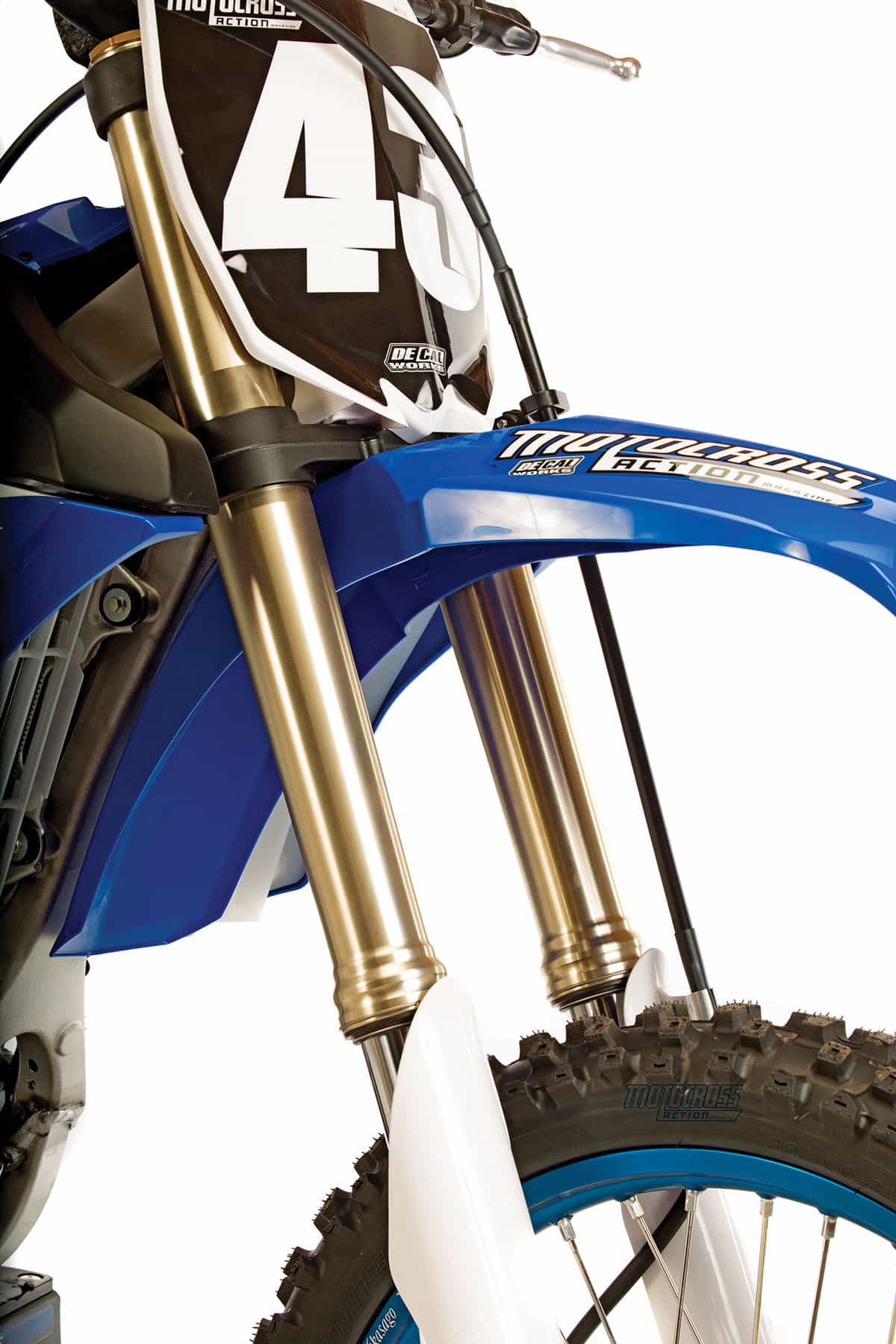 We give Yamaha kudos for holding firm on their superb Kayaba SSS spring forks when everyone else switched to air.
We give Yamaha kudos for holding firm on their superb Kayaba SSS spring forks when everyone else switched to air.
KAYABA SSS FORK SETTINGS
These are awesome forks. They are relatively unchanged from the past, but that’s not a crime in SSS land. If you are under 150 pounds, consider dropping the fork springs to the optional 4.5 N/m rate. You can also lower the oil height in 5cc increments until the desired performance is met. Most MXA test riders felt that the fork springs were sufficient for a wide range of rider weights and speeds. For hardcore racing, we recommend this fork setup for the 2018 Yamaha YZ250F (stock specs are in parentheses):
Spring rate: 4.6 N/m
Compression: 14 clicks out (11 clicks out)
Rebound: 14 clicks out (12 clicks out)
Fork-leg height: 5mm up
Notes: Don’t be afraid to make very large swings in compression and rebound clicker settings. We tested everything from 10 clicks out to 20 clicks out. These big alterations help you zero in on the perfect numbers for your style. As a rule of thumb, we ran less compression damping and rebound than stock. This helped the front tire track the ground better.
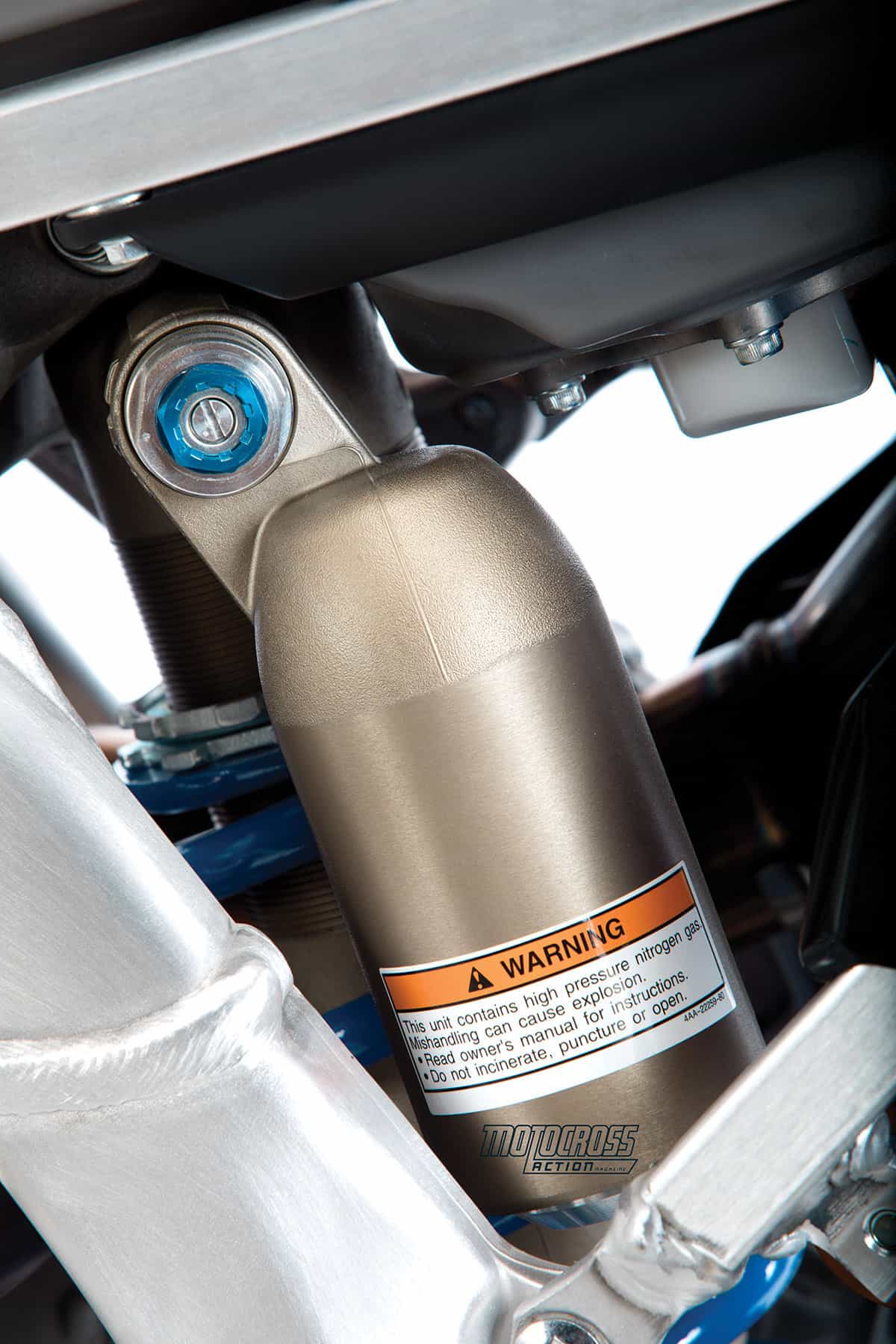 The YZ250F’s Kayaba rear shock is flawless once you get it set up right.
The YZ250F’s Kayaba rear shock is flawless once you get it set up right.
KAYABA SSS SHOCK SETTINGS
We love this shock—although we don’t think there is enough rebound damping. To calm the shock down, we went way in on the rebound as well as the high-speed compression. Once we got the settings dialed, it worked for lightweights and heavyweights. Only the sag needed to be adjusted. For hardcore racing, we recommend this shock setup for the 2018 Yamaha YZ250F (stock specs are in parentheses):
Spring rate: 54 N/m
Race sag: 103mm
Hi-compression: 1/2 turn out (1-1/8 turns out)
Lo-compression: 11 clicks out (11 clicks out)
Rebound: 4 clicks out (14 clicks out)
Notes: If the bike feels too tall at 103mm of sag, drop it down. Drop the forks a few millimeters as well to balance the bike out.
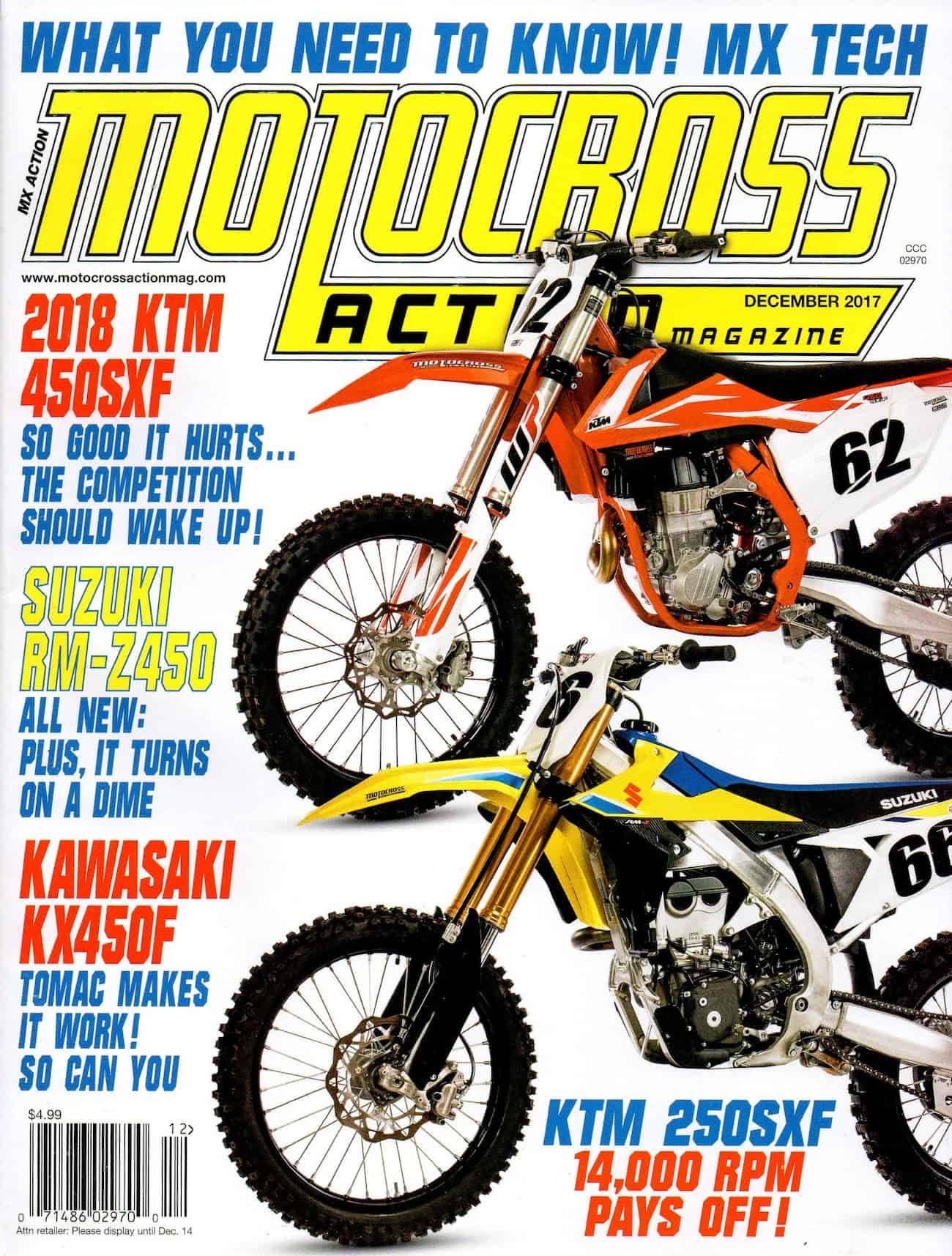 Had you subscribed to MXA, you would have read this complete bike test when in came out back in November. Click the box below to subscribe.
Had you subscribed to MXA, you would have read this complete bike test when in came out back in November. Click the box below to subscribe.


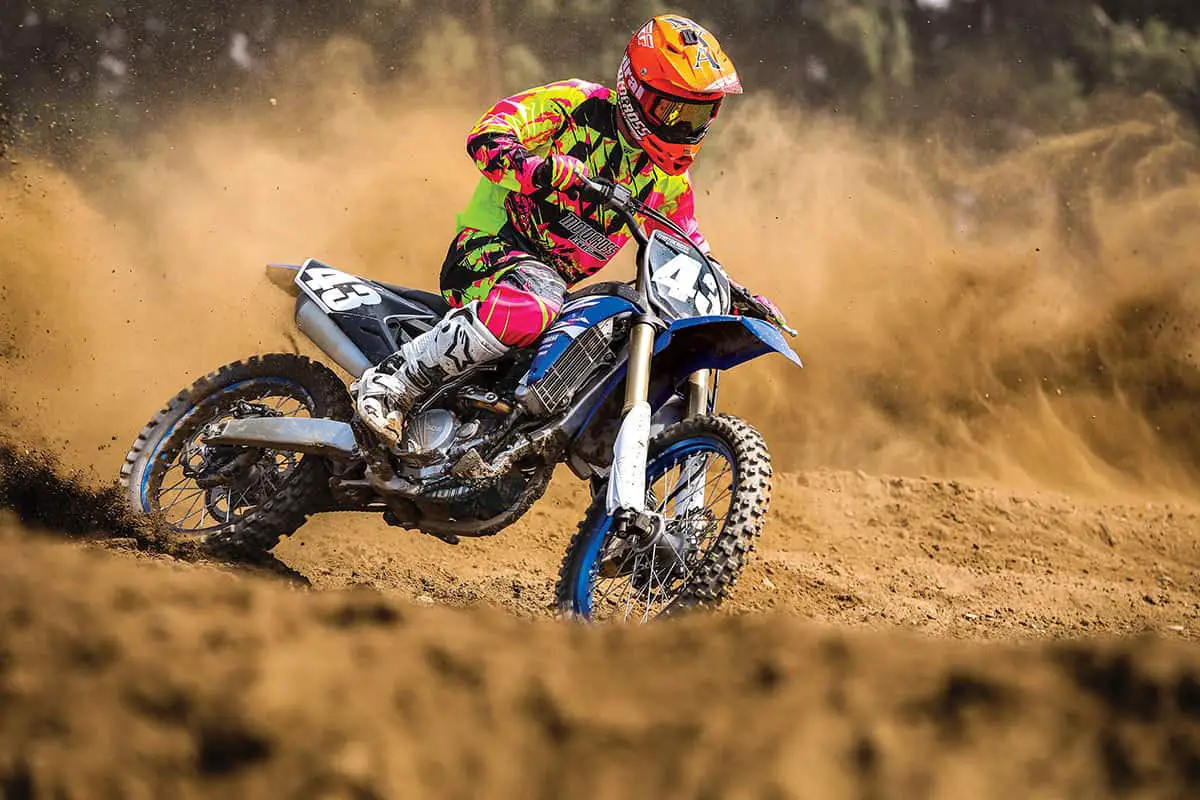
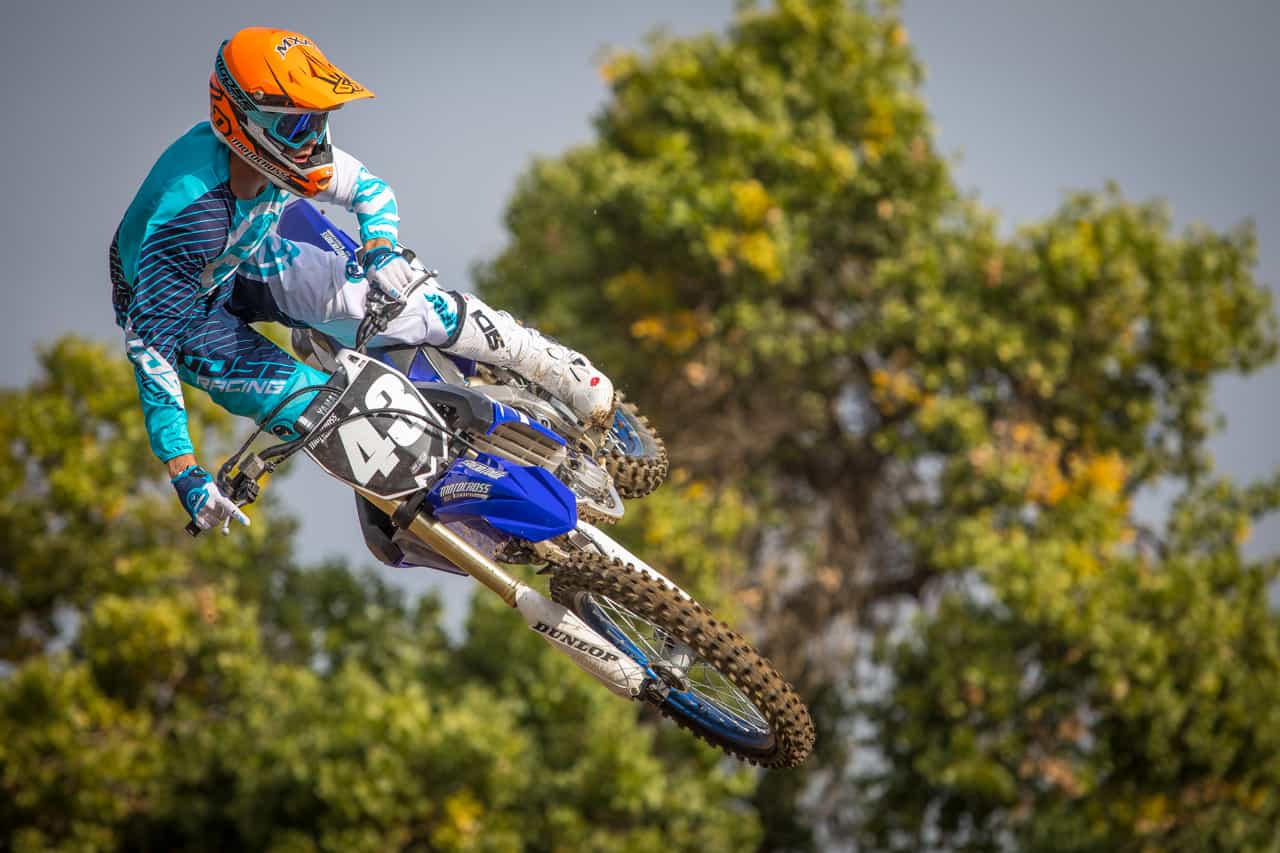


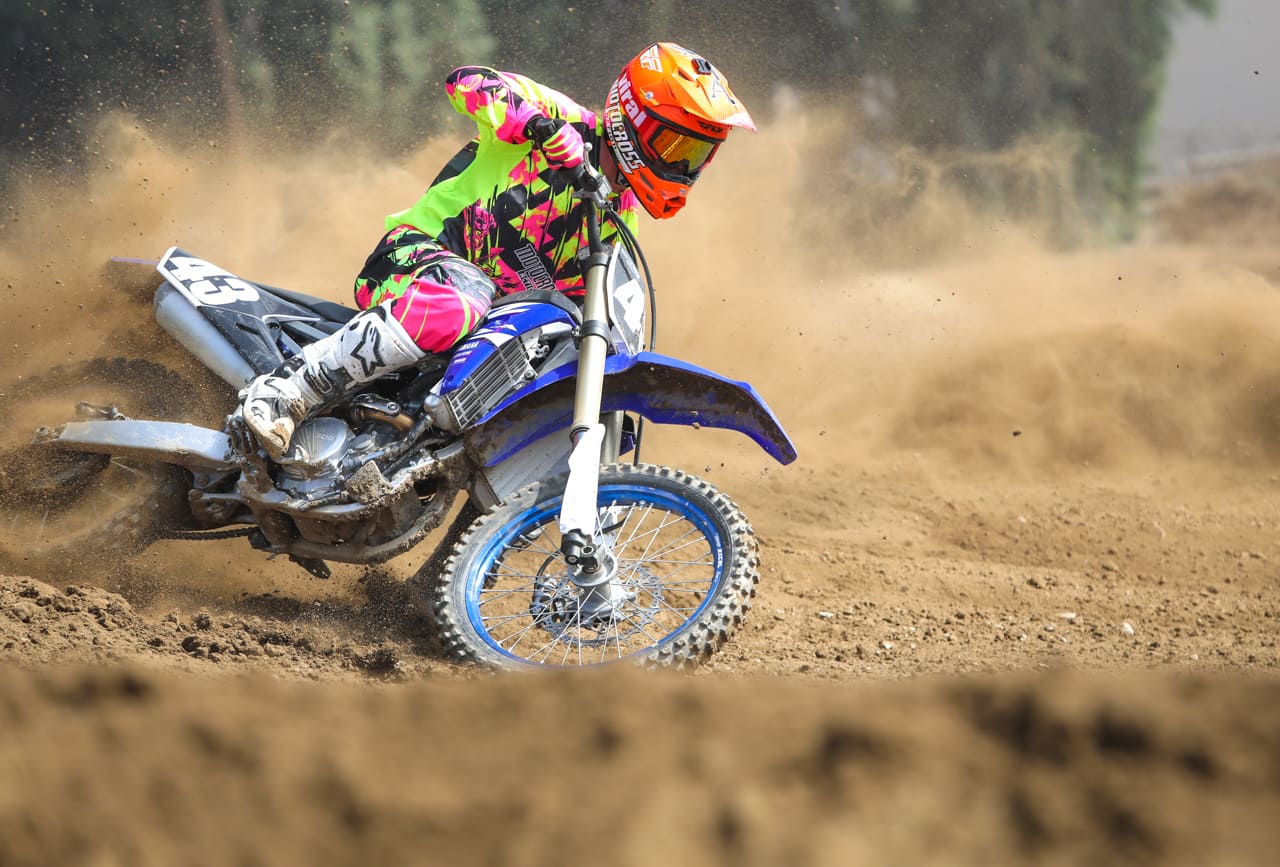
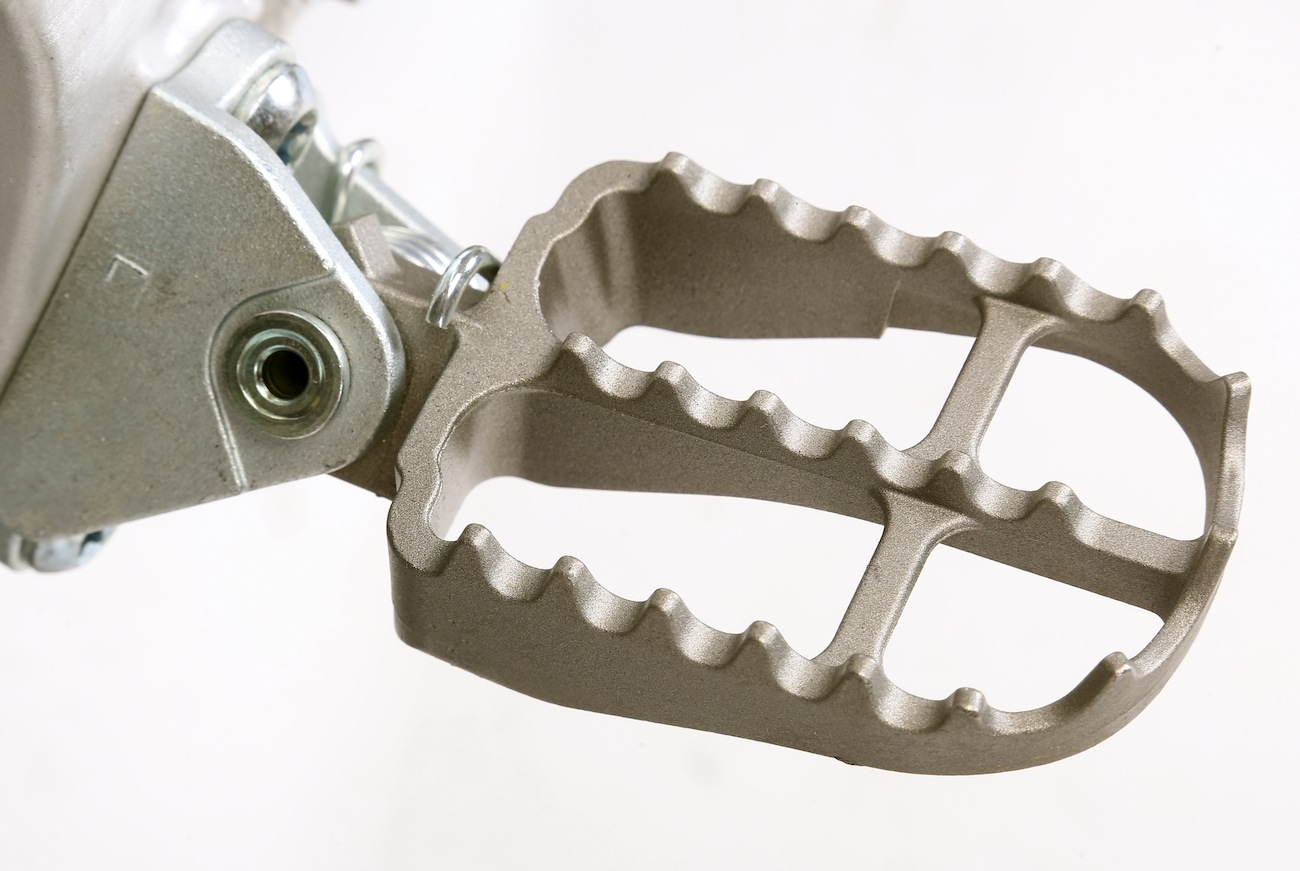



Comments are closed.